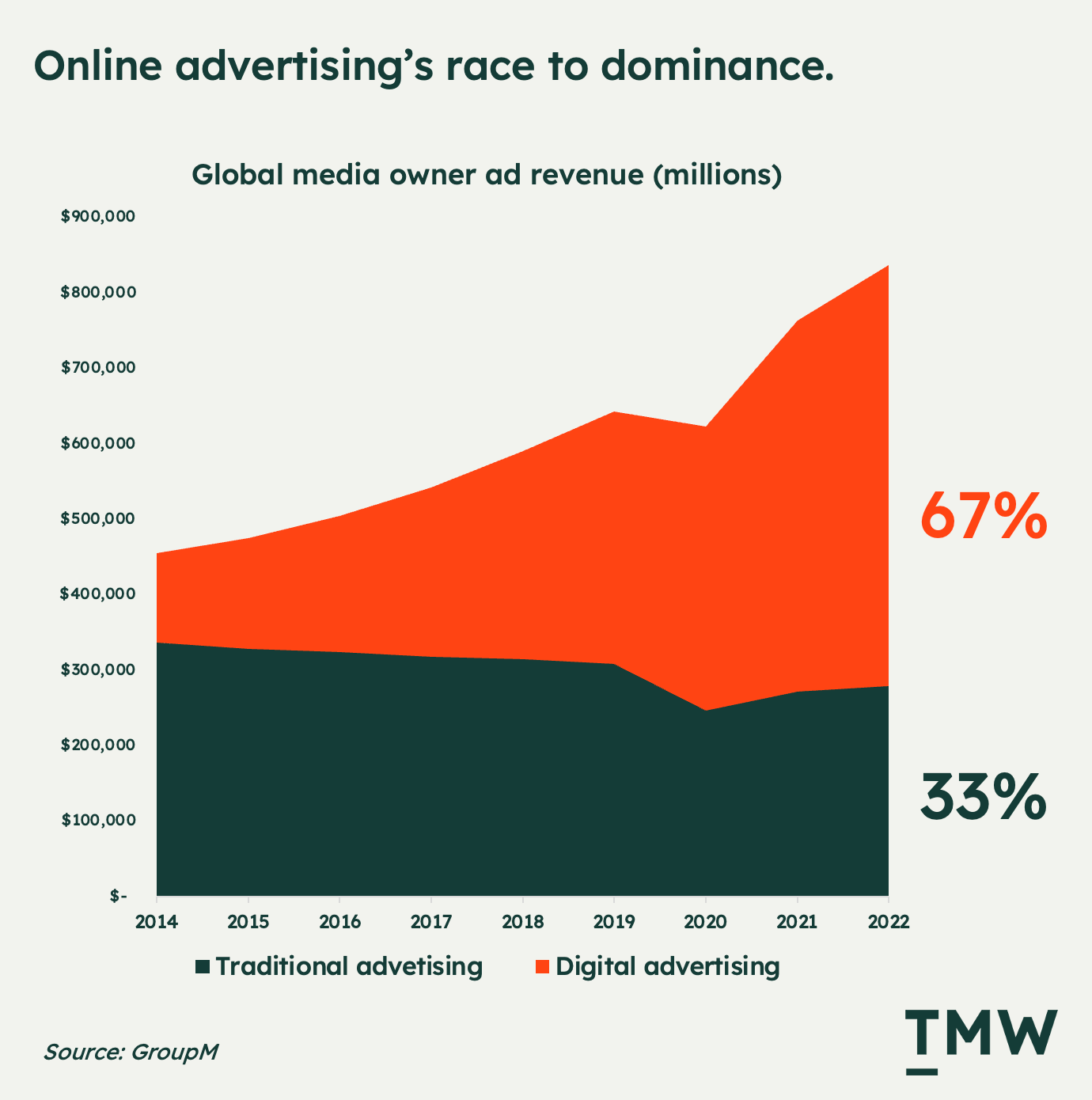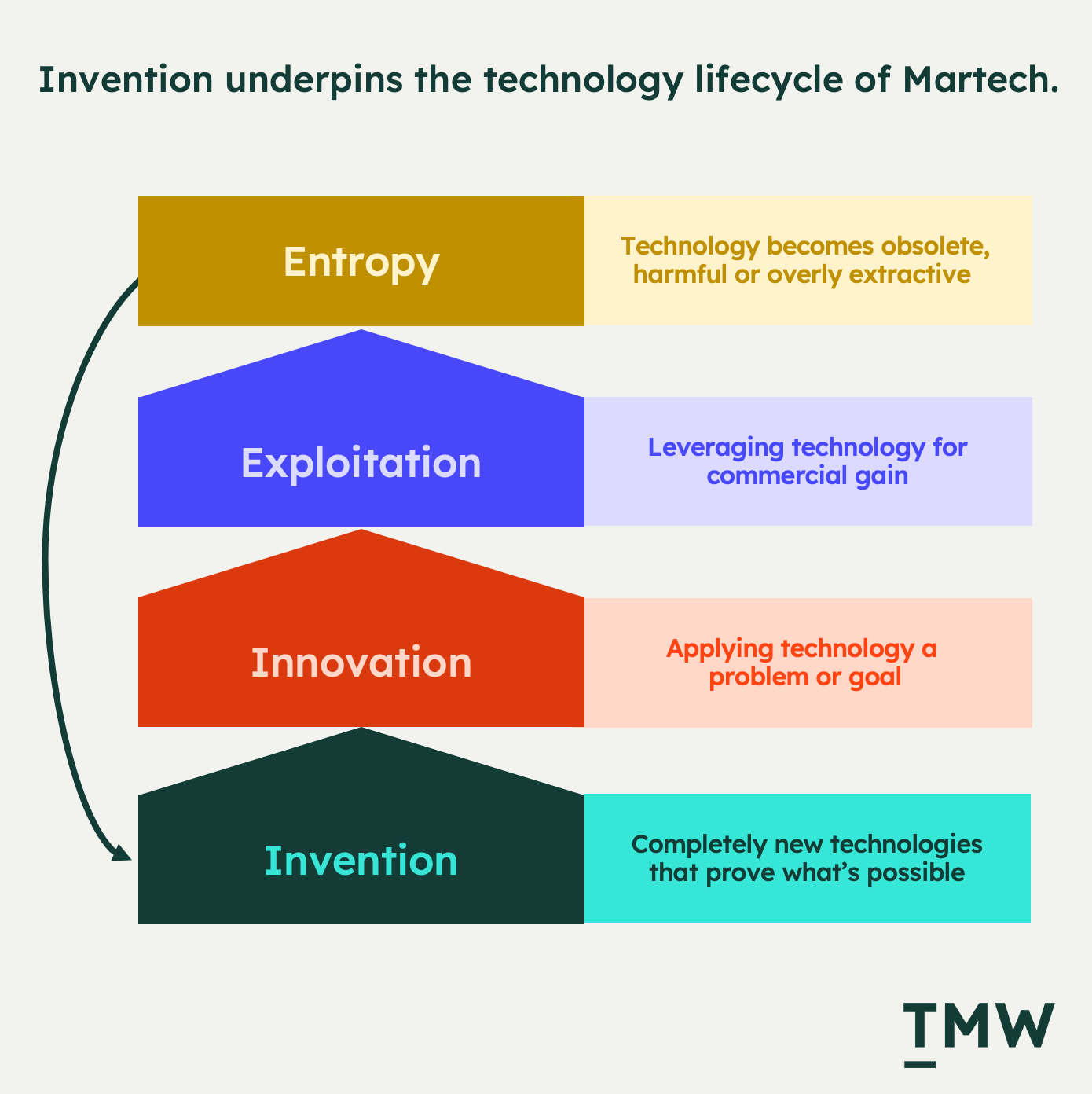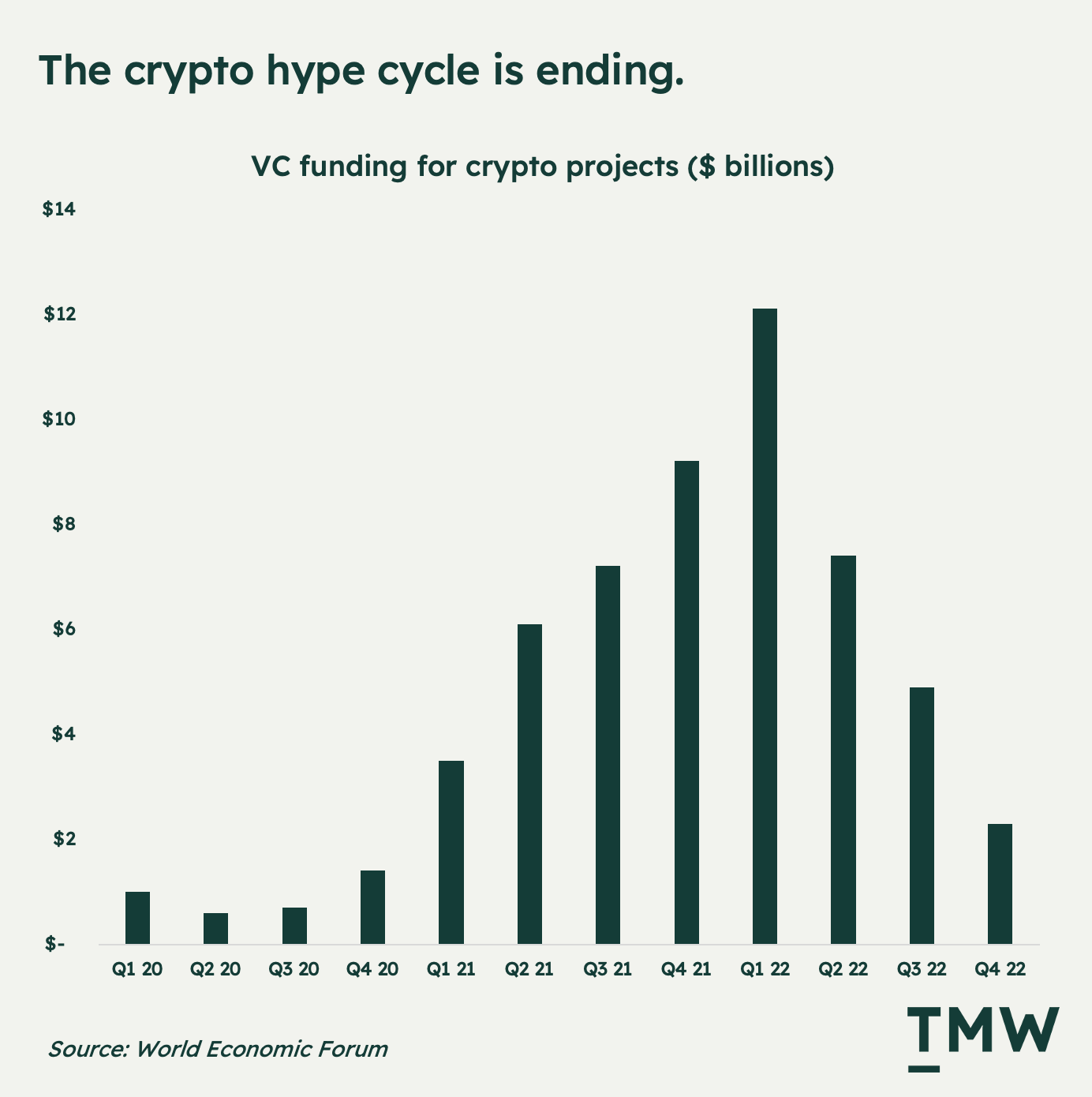TMW #108 | 2023 and the era of invention
Welcome to The Martech Weekly, where every week I review some of the most interesting ideas, research, and latest news. I look to where the industry is going and what you should be paying attention to.
👋 Get TMW every Sunday
TMW is the fastest and easiest way to stay ahead of the Martech industry. Sign up to get the full version delivered every Sunday for this and every TMW, along with an invite to the TMW community. Learn more here.
This is the first TMW newsletter for 2023. It's great to be back with you all.
Before we get into regular programming I'd like to remind you of TMW PRO. So far, customers who've signed up are finding it a faster and more enjoyable way to get ahead of what's happening in the Martech industry. 2023 is set to be another big year, with a lot of change, and new opportunities.
You can give it a go for free for 30 days. Plus you get to be my boss. Your conversion to paid is my performance review.
Are you ready for 2023? Let's do this... Upgrade to TMW PRO
2023 and the era of invention
Ernest Rutherford, a physicist in the early 20th century, was an inventor. He was behind the discovery of the atomic nucleus, alpha and beta radioactivity, and the discipline of nuclear physics as we know it today. He also had an interesting perspective on the commercial impact on his inventions:
Rutherford was known in later years as a hard man with a research budget, unwilling to accept grants from industry or private donors, unwilling even to ask, convinced that string and sealing wax would carry the day. He was actively hostile to the commercialization of scientific research, telling his Russian protégé Peter Kapitza, for example, when Kapitza was offered consulting work in industry, “You cannot serve God and Money at the same time.”
From The Making of the Atomic Bomb, Richard Rhodes.
Like many of the scientists in the early 20th century, there was a deep culture driven by the purpose to improve the state of humanity by understanding physics and chemistry, the bedrock of the technology industry. These people were the inventors who brought you science that led to the radio, the refrigerator, nuclear energy, and the microprocessor. They also believed that invention should be for its own sake, not only for commercial ends.
Why am I taking you back to the early 20th century? Well, in 2023 the role of marketing technology in the broader information environment is shifting out of a season of exploiting the technologies of the past to what I hope will be a new season of invention.
In this essay, I’ll be talking about what kinds of inventions I hope to see over the coming years and in 2023. We are at an inflection point in the economy, impacting the technology industry and how consumers interact with brands. But what does it look the age of invention look like? Let’s dive in.
From invention to exploitation
Martech is an industry characterized by exploitation. The main question asked of the people working in it, including all the vendors, marketers, consultants and researchers has been this – how can we harness the powerful technology of the internet to create value for business?
And over the years, many companies did exactly that:
- Amazon leveraged SSLs, payments, and the early web to capitalize on the e-commerce opportunity, and later took it a step further with the data centre by offering cloud storage with AWS
- Facebook (now Meta) was able to harness our attention using open internet protocols (HHTP) and later the invention of the smartphone to build the world’s largest social network
- Salesforce built its CRM business off the back of SMPT, the open-source invention that became the email
- Google both leveraged the content on the early web by organizing it with an optimized ranking algorithm that many others in academia were also working on at the time
All of these companies represent some of the most valuable assets in the world, coming to prominence in a very short time span historically. And they should: like the airlines, energy, and auto manufacturers before them, they were able to successfully take an experimental technology, build process, train talent, and find customers to create value. Good for them.
For the marketers – and digital folks who have experienced the past twenty years of innovation in Martech – they’ve also been able to take advantage of breakthrough technology.
Meta brought high volume reach and precision targeting to the masses of businesses that could never afford the big budgets of traditional advertising. Amazon made the distribution of products more accessible for retailers. Google created a whole discipline (SEO) by creating a performative way to get content in front of people. Salesforce put archaic CRM software into the browser and made life easier for millions of salespeople.
Marketing has been punctuated by internet innovation over the past 25 years. As each wave rolled in, the job of marketing in companies has been to figure out what the new things are and often to assess their value and practical feasibility. From 1995 to now, marketing has transformed.
The volume of ad spend poured into internet communication technologies is far greater than any other channel share today. If you’ve been working in Martech over the past ten years, congrats – tech conquered marketing. To use the words of Marc Andreessen, software has eaten the world. And it swallowed marketing with it.

The tech recession turning point
But now most of these companies are facing the eventual other side of the growth curve. In 2023 I believe that we will see the titans of yesterday fall further into obsolescence, greater consumer exploitation, and disruption. Is 2023 the year where we see a shift not only in the value of these companies, but in new inventions that can effectively replace them? It’s possible. Very possible.
The signs of a technology recession are everywhere: from Salesforce decreasing headcount by 10% and cutting expenditure by $3 to $5 billion, to the proliferation of staff layoffs across the SaaS sector, to the failure and collapse of the Web3 crypto economy. Even Amazon and Apple’s push into advertising in search of high-margin and scalable revenue indicates an environment where there are too many competitors and not enough eyeballs to sustain the business models of Covid-19. It’s been rough out there and the markets are putting in their no-confidence votes.

But it goes deeper than the headlines. All of a sudden, capital became more expensive in the United States, consumers started spending more time outside after the pandemic, and then inflation started to rise after billions were spent on pandemic relief programs.
This has made the value of the digital economy tenuous. The tech sector has been on a long march of growth over the past decade as more people go online. But 2022 was a decided shift away from that growth.
In many ways, the pandemic was not a new era for tech, but the last gasps of an era gone by. And that’s ok! Every tech cycle needs to come to an end to make room for another movement. 2023 feels like a turning point – the first step in the next twenty years of new technologies that marketers can turn into growth and value.
Inventing Martech
So, what could this new era look like? I think some very interesting inventions are now reaching a usability phase, which is important to uncover and understand. Like most of scientific research, it can take decades for some technologies to reach a point at which they can be used by companies. Some of them are starting to reach a new plateau that we’re just trying to figure out.
The cycle for how new technologies are created and commercialized is fairly straightforward and tends to repeat throughout history. First is the invention phase, where there are no rules and no use cases – just experimentation. Innovation is applying novel ideas to goals or problems, while exploitation is taking an invention to market for commercial gain until it starts to spiral into entropy and the cycle starts again. Martech in 2023 is somewhere in between exploitation and entropy – most of the so-call innovation bandied about today relies on decades-old foundational tech.

The domain of invention is also the domain of danger. Famously, William Nelson ended up dying after experimenting with a new way to motorize a bicycle – because it went too fast! It’s no different in this century than it was in the last. There’s plenty of reason to believe that new technologies have the potential for fortune but also fatality.
Most of what I’m about to walk you through will likely never make it to commercial success, but there’s effort and energy directed toward it, so it’s worth discussing. With that disclaimer in mind, here’s what I’m hopeful for as we roll into 2023.
1. Generative technology and the information ecosystem
There’s a lot of hype surrounding OpenAI’s suite of products including ChatGPT, the chat window that can answer almost anything you throw at it; DALL·E 2, the image generation platform; and GPT-3, the multipurpose developer application for language.
OpenAI’s mainstream influence on AI invention should not be understated. Microsoft is looking to integrate its AI products into its portfolio (including Bing), while other tech giants scramble to figure out how to best apply this technology. Even Apple is jumping into the fray with an audiobook tool that auto-narrates books.
OpenAI is seeking $29 billion in new funding, which is a strong signal for even more development in the commercial application of AI. This is the outcome of years of research and invention.
As I argued in TMW #107:
“The growth of ChatGPT is just one small milestone in the bigger picture of funding for AI startups. Over the past four years, and particularly in 2021, more than $100 billion has been invested in the technology category. Well-funded startups, with a long runway, means a lot of opportunity for innovation. What we’re seeing with OpenAI’s release of DALL·E 2, and ChatGPT in 2022 is the consequence of funding from years ago.”
The explosion of AI tools is already surfacing tangible use cases that solve real-world problems like pulling in data into a spreadsheet and augmenting search engines that change the premise of search from “search engine” to “answer engine” along with video generation using only AI tools. AI is one of the inventions that is spawning an entirely new cycle of exploitation, and has the potential the augment so much of how consumers experience the web.
2. Quantum computing and the new interface
This one is years away, but the power that quantum computers represent will be one of the key inventions in the coming decades that accelerate things like artificial intelligence, and virtual and augmented reality in ways that make new experiences entirely possible.
One of the major problems of virtual and augmented reality is that the computing power and internet connectivity speeds are nowhere near where they need to be to facilitate seamless experiences that deal with the real world. New wearable devices that should become a seamless part of our daily experience cannot lag or be clunky. That’s why VCs have started noticing the computing power that is powerful enough to break the world’s encryption standards that keep our passwords safe.

While Meta has been working towards virtual worlds (and failing badly), the real opportunity in Martech invention is the ability to better augment the real world with digital devices. Apple is rumoured (like every year before it) that it will make its first steps with a new AR/VR wearable device this year. It’s likely to be a form of pro hardware that might cost more than $3,000.
The metaverse as a concept was partially pointed in the right direction, with the wrong time and place in execution. Meta’s approach was to give new language for the invention of VR. We’re still a long while away, but moving from screens to more portable and wearable devices that seamlessly integrate with our real-life experience seems like a technology that can be exploited!
The way humans interface with the internet is based on some very old concepts. It’s actually quite interesting that all this time the way we communicate with computers and smartphones follows the same format as the mechanical typewriters that are hundreds of years old. It’s inevitable that we will find ways to make internet connectivity more seamless and like real life. For that to happen, compute needs to improve and internet connections need the speed!
3. Decentralization and society
Web3 as a social movement was a mess of contrived scams, empty speculation and Ponzi schemes that tried to turn worthless digital assets on blockchains into valuable investments. Many of the new companies that rolled into the decade-old crypto space have been exposed as fraudulent after promising a more decentralized future of the web. Three Arrows Capital, Terra, FTX, and OpenSea are all major player involved in serious fraud cases and losing billions in retail investor dollars.
For this reason, VC interest in crypto projects has dropped off a cliff:

But the message of Web3 has some merit to it, even if it hasn’t lived up to it. The idea of making the web less of a winner-take-all environment – controlled by major tech companies that own the lion’s share of data, attention and commerce – is valid and should be explored.
The problem with the scalability of the internet is that it creates strong network effects that are hard to break. It has a long-term staying power because if everyone is using a certain platform then everyone will use it.
Dror Poleg suggests that the network effects and the mainstream technologies that enable the distribution of information follow a winner-take-all paradigm. The more popular the content or product, the more distribution it gets. He argues that this paradigm creates an unfair and unequal playing field for the internet’s users and companies; before the web, good content = popularity, but the internet turned that inside out, and today, popular = good.
Decentralized technologies are attempts to create services that rival or go beyond what we see today from big tech but are formed on the basis of shared ownership and control. The blockchain was supposed to solve this, and in a small way it does: it creates P2P network structures that reduce (but do not eliminate) a centralized controlling party for financial transactions.
I do think that something like BlueSky or even Urbit or Mastodon are all trying to invent new ways to break the social network monopoly up and give more value back to users. For marketers, this means more choice and less reliance on a handful of corporations.
I don’t think the blockchain is efficient, scalable, or useful enough for a decentralized internet. But it could be the forebear of new inventions that solve the problem of centralized control over information, socialization, and commerce. While this is less a technological and more a social and cultural paradigm shift, it’s no less important to understanding how regular people will navigate and use the web. In other words, I’m hoping for fewer internet overlords.
4. Data architecture and a private web
The cloud is still early judging by how many companies actively use it for managing their data architecture. Most of this is caused by decisions made and technology purchased decades ago by the big enterprise companies. It’s hard to escape IBM mainframes and Seibel CRM systems when your entire business is built on top of it.
But data architecture is changing in all kinds of directions. One of the things driving change is the inventions surrounding cloud storage, to make it more secure, faster, and scalable to serve customers better. In a lot of ways, the data centre is primitive: it’s a big warehouse that needs a lot of power and cooling to make it work. It also needs to be near the customers that send and retrieve data from it. So, there’s a lot of inefficiency that can be challenged with new inventions.
Right now, the technology is still impressive: being able to store and compute teraflops of data in split-second recall is a magical invention that should be celebrated. But it can always get better.
On the other side is the technology that’s invented to better leverage the data warehouse, mostly in relation to data sharing and use for advertising.
Companies like TripleBlind are inventing algorithms to make data sharable between companies for research and advertising purposes while maintaining privacy. This is important as privacy continues to influence how the marketing and advertising industry prepares for a more private web.
If anything, the shift to privacy will bring about a much-needed revitalization and replacement of the data types we’ve been using to power marketing since the dawn of the web. Third-party cookies should retire – they are old! So are the DSPs and the opaque ad networks that funnel ad dollars through multiple parties. There’s so much the industry can do to improve the situation here. Cheaper, better and faster!
Even this week The Trade Desk has announced a new first-party data tool that will help brands integrate with their broader data activation and programmatic offerings. Samantha Jacobson, the Chief Strategy Officer at The Trade Desk recognizes the shifting sands of internet infrastructure:
"The infrastructure of the internet is embracing new identity solutions built for today’s digital media consumption across different devices and apps, such as Unified ID 2.0. In doing so, they are creating the richest identity ecosystem we’ve ever experienced, and one that aims to put consumer privacy at the forefront."
This is yet one of a thousand examples of the chaotic state of cookie replacement and responding to mobile tracking deprecation with ATT. There’s innovation here, and some invention, but it's reactive; trying to find something else that will bring the vendor dollars in is perhaps not the best incentive for radically new paradigms for customer data.
Freeing invention from its commercial shackles
One of the major concerns I have rolling into 2023 and beyond is that so much so-called innovation is driven by the big tech layer of the economy, but so much more invention should be coming from outside of this domain.
Why? It’s not commercially viable to have teams of people work on tech and solutions that will most likely not have any real application or return on investment. Sure, they might indirectly influence the next big breakthrough, but if it’s not contributing to the next quarterly earnings reports, it has a tough time surviving.
That’s why universities exist: they are funded to burn cash on improbable ideas and inventions that will never make it out of the lab. But firms like Google, Amazon and Meta are so intertwined with leading universities that their influence and funding may indeed further entrench these tech leaders as the only ones that can change the internet landscape.
We need the tinkerers, the explorers, and the inventors to bring novel ideas, fresh inspiration, and most importantly, new foundations for how we interact on the web. Going back to Rutherford’s perspective: he avoided commercialization, despite owning the inventions that lead to society-changing technology because he saw that the end of the commercial path only leads to entropy. There’s nothing new there.
Invention is about new ways to make the world a better place. But Martech is about the exploitation of those inventions for commercial gain. Invention steers the course of how Martech will work into the future. And that’s why need more people working on the hard problems of LLMs, quantum computing, decentralization, and data infrastructure without the commercial influence.
Despite the looming recession and the tech downturn, I’m hopeful that 2023 will become the launching point for a whole new season of novel invention.
Stay Curious,
Make sense of marketing technology.
Sign up now to get TMW delivered to your inbox every Sunday evening plus an invite to the slack community.
Want to share something interesting or be featured in The Martech Weekly? Drop me a line at juan@themartechweekly.com.
